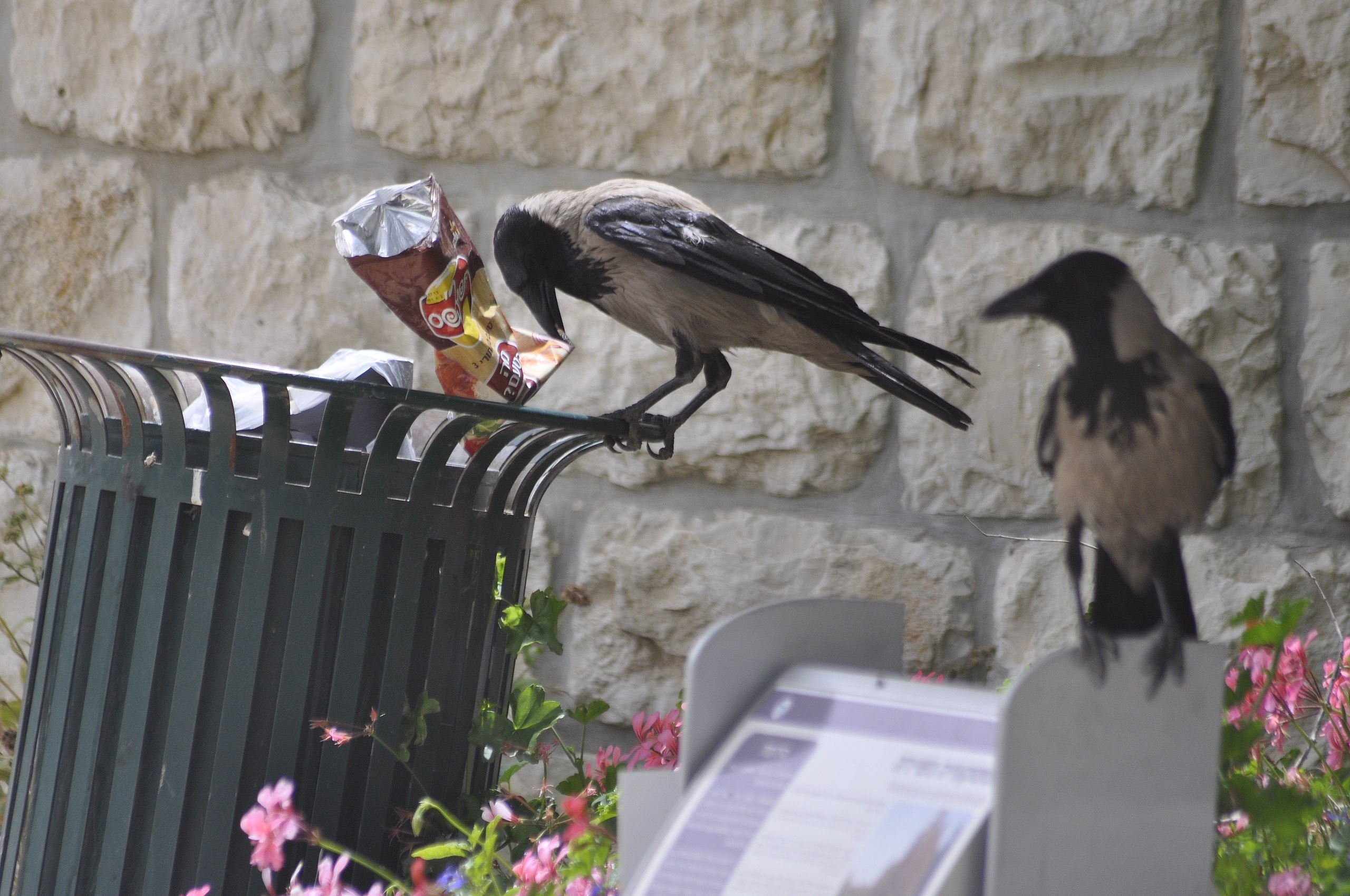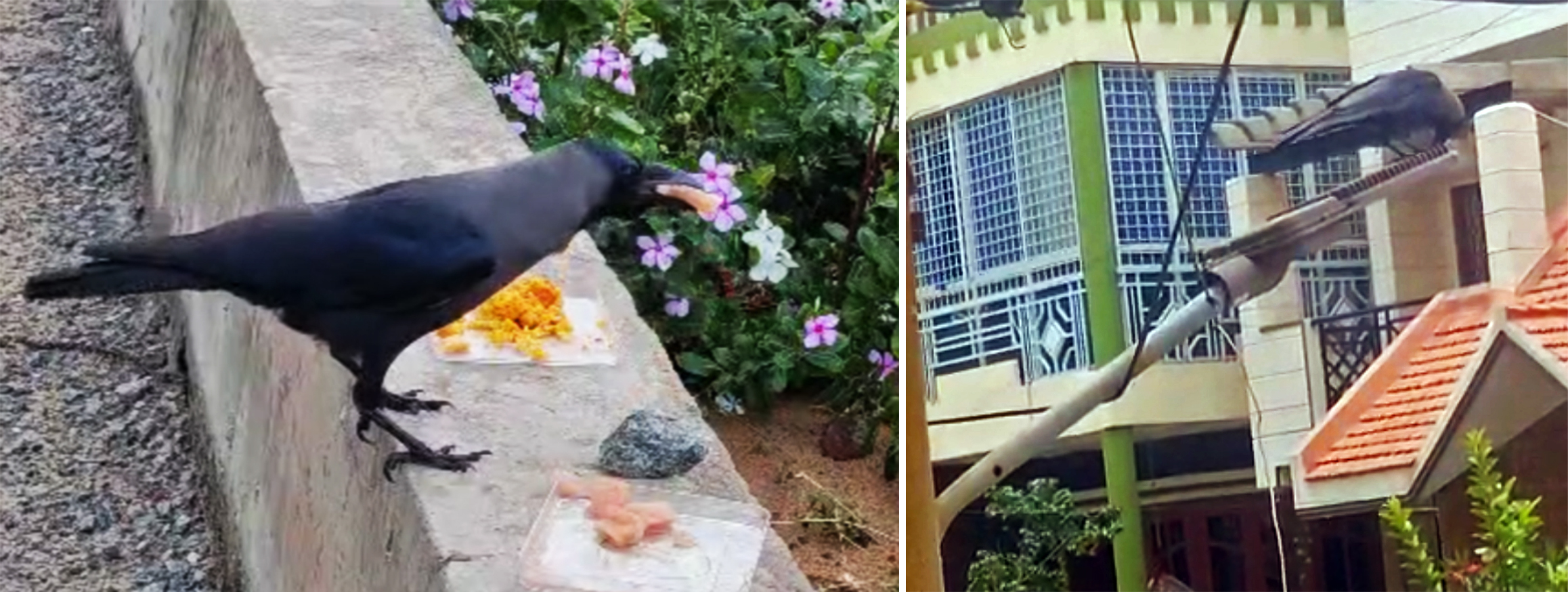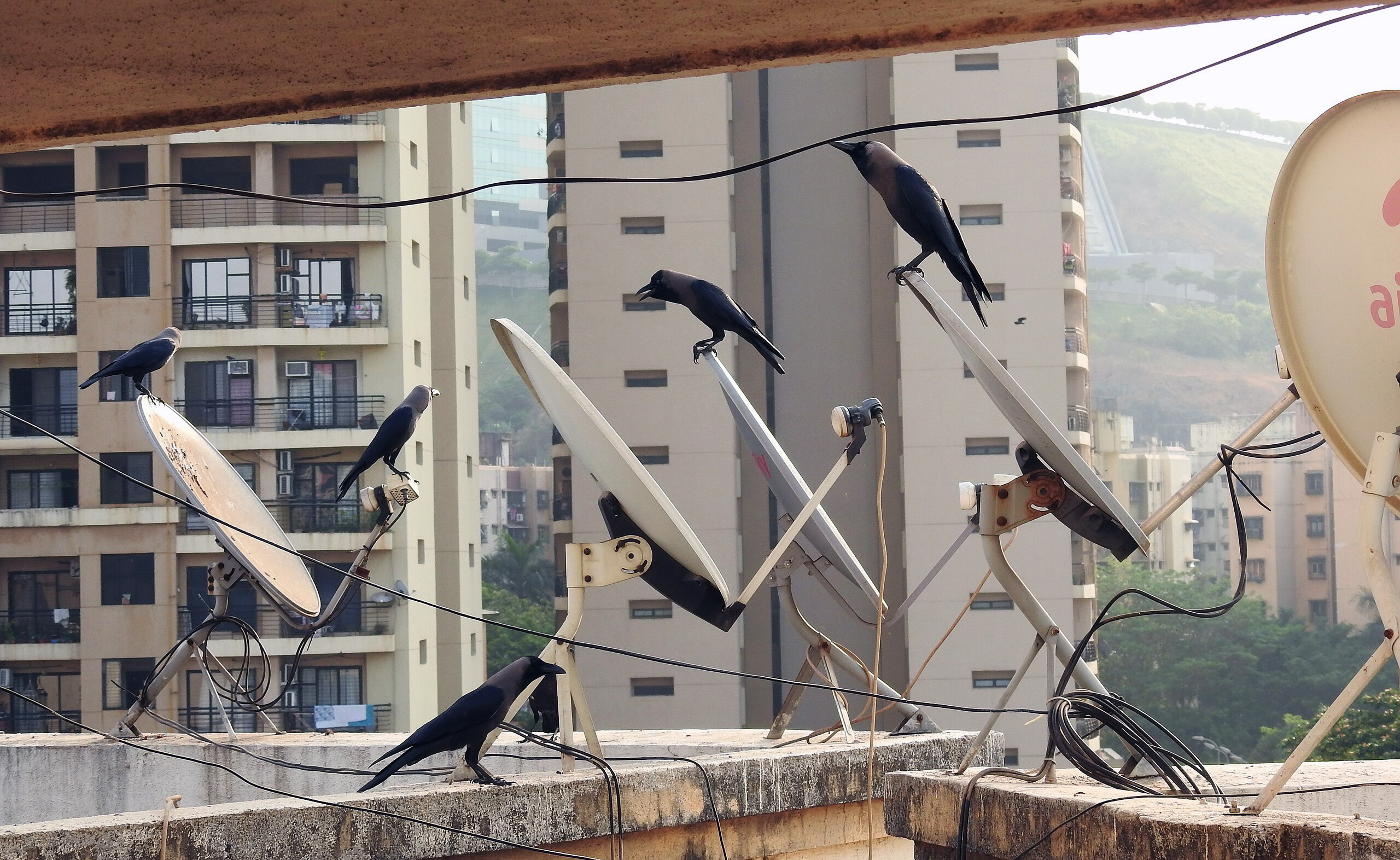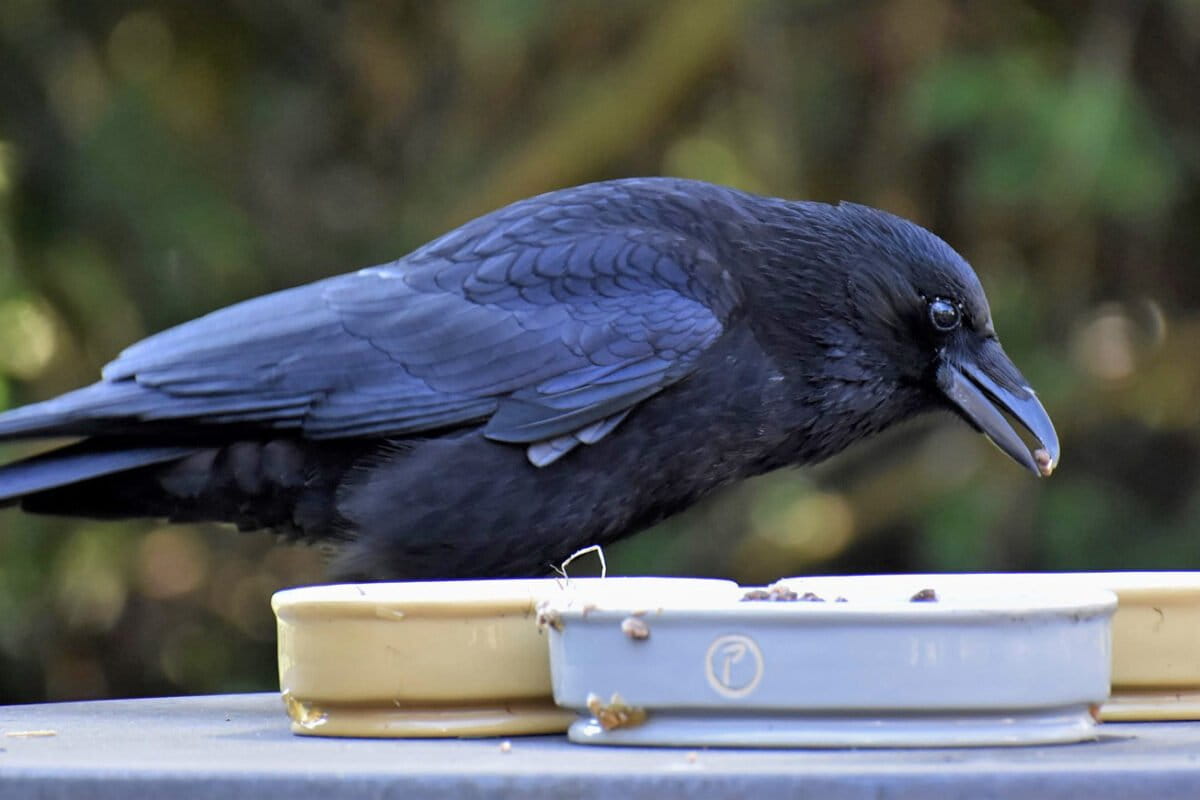- Crows and other corvids exhibit remarkable intelligence — including tool use, problem-solving, memory and even social awareness — challenging long-held assumptions that such cognitive abilities are exclusive to humans or primates.
- Scientific research and experiments, some inspired by popular fables about clever crows, show that these birds understand cause and effect, plan for the future, and adapt their behavior based on context, environment and who’s watching.
- Urban crows thrive due to cognitive flexibility, as shown in an ongoing experimental project in India, which highlights their strategic foraging, memory and ability to learn and adapt in human-dominated environments.
- This article is a commentary. The views expressed are those of the author, not necessarily of Mongabay.
Corvus splendens — Corvus meaning ‘raven’ in Latin and splendens meaning ‘shining’ or ‘brilliance’ — is a fitting name for the strikingly intelligent birds that house crows are. Crows have long captured human imagination, perhaps most famously in Aesop’s classic fable The Thirsty Crow. In the story, a clever crow finds a pitcher with water too low to reach and solves the problem by dropping pebbles into it, raising the water level until its beak can reach it.
For centuries, this tale was seen as mere folklore with a moral: Persistence and intelligence are the key to success — an example of human storytelling rather than avian truth. But, the science of animal cognition, particularly through the pioneering work of researchers such as Sara Shettleworth, Canadian experimental psychologist and zoologist, began to challenge those assumptions. Shettleworth and others asked: what if these stories held a kernel of truth? Could animals like crows really think through problems, use tools, and even plan ahead?
As research progressed, especially within the field of comparative cognition, scientists began to uncover astonishing evidence that corvids — like crows, ravens, jays and jackdaws — possess advanced mental abilities. Experiments inspired by the fable, in which real crows were presented with water-filled tubes and objects to drop in, showed that New Caledonian crows (Corvus moneduloides) dropped stones into water-filled tubes rather than sand-filled ones, chose sinking objects over floating ones, preferred solid to hollow materials, and even targeted tubes with higher water levels — choices that suggest a clear understanding of how their actions would affect the water level, hence food. This was a glimpse into a mind capable of understanding cause and effect, using tools, and perhaps even imagining future outcomes.
Crows are street smart. In Davis, California, crows adjust the height from which they drop walnuts based on the nut type — researchers observed harder black walnuts were dropped from higher up than the softer English walnuts, which they chose to drop on pavement rather than on soil. They also seemed to factor in social risks: When fewer rival crows were nearby, they flew higher before dropping nuts, minimizing theft. These behaviors highlight the crows’ ability to make smart, flexible decisions based on context and experience.

Corvids are also masterful hoarders, caching not just food but also stones, nesting materials and colorful objects. Among them, the Clark’s nutcracker (Nucifraga columbiana) stands out: Each autumn, it hides over 30,000 pinyon pine seeds across thousands of sites to prepare for the long winter. Remarkably, these birds can recover their cached seeds even nine months later. Their secret lies in sophisticated spatial memory: They navigate using stable, vertical landmarks, such as trees and rocks — features that remain visible despite snow or shifting terrain. This strategy reveals not just memory, but foresight and an ecological intelligence finely tuned to survival in a changing landscape.
Scrub jays (Aphelocoma genus), which were referred to as ‘nature’s psychologists’ by English neuropsychologist Nicholas Keynes Humphrey, employ several cache protection strategies at the time of caching, all of which appear to reduce pilferage — or theft by other animals — by minimizing the amount of visual information available to the observer. Ravens (Corvus genus) are masters of covert caching, often choosing ‘out-of-view’ spots to stash their food when conspecifics are nearby. However, when those neighbors are distracted, ravens seem to abandon their usual secrecy and cache openly.
Rooks (Corvus frugilegus), on the other hand, offer an intriguing twist: They show little concern when other nearby rooks are also caching. But if a rook without a nut lands nearby, the cacher immediately suspends its activity, grabs its nut, and waits for the newcomer to leave. This behavior suggests that some corvids don’t just respond to who’s watching, but they can also measure the observer’s attentional state as well. In other words, cache protection strategies depend not only on the presence of potential pilferers but also on whether those pilferers are paying attention.
Research has shown that these birds can recall the specifics of past caching events: what they hid, where they hid it, when they did it, and even who might have been watching at the time. This remarkable ability to mentally replay past events referred to as ‘mental time travel,’ believed to be unique to humans, checks all the boxes for what scientists call episodic memory. The full ‘what-where-when’ in episodic-like memory has yet to be convincingly demonstrated in non-human primates. In the intelligence stakes, crows are not just keeping up with the primates.
Understanding how birds like house crows engage in complex cognitive tasks not only challenges long-standing assumptions about the uniqueness of human or primate cognition but also opens up new avenues for conservation biology and urban ecology. Insight into how corvids remember, plan and adapt can inform conservation strategies, particularly for species living in fragmented or human-altered landscapes. In urban environments, where crows often thrive, their problem-solving skills such as utilizing anthropogenic wastes as building materials for their nests, using poles for hiding food, exploiting human food, and social awareness may serve as indicators of how wildlife adapts cognitively to anthropogenic change.
In India, a project studying the survival of urban crows in the cities — called the Cawgnition Project, initiated at the Animal Behaviour and Cognition in Conservation (ABCC) research laboratory in the Centre for Urban Ecology, Biodiversity, Evolution and Climate Change (CUBEC) at Jain University, Bangalore, with Amrit Pritam Mohanty and Shubhrajyoti Adhikary from the Indian Institute of Science Education and Research (IISER) — arrives at a pivotal moment in urban ecology research. It seeks to answer a compelling question: “What makes crows so extraordinarily successful in urban environments?”


Preliminary results point to remarkable cognitive flexibility and problem-solving abilities in house crows. In controlled experiments, these birds consistently chose their favorite food rewards, even when easier options were readily available, showing persistence, discernment and goal-directed behaviors. This cognitive sophistication likely plays a key role in their ability to accept and evaluate anthropogenic food sources, which suggests that crows not only adapt to human environments but also learn about new food opportunities through experience and experimentation. In many ways, this validates what folklore has long suggested: the classic ‘thirsty crow’ fable. Current research-based observations like the Cawgnition Project offer a modern scientific lens through which to view this age-old story, showing that urban crows don’t just survive, they strategize, persist and show striking intelligence; they thrive, indicating rapid adaptability in human-dominated habitats.
Another intriguing observation by a student at CUBEC documented a house crow engaging in strategic food caching. The bird was seen discreetly hiding a piece of meat when other family members were not present and later returning to it once the area was clear to retrieve the now-dried meat. This behavior showcases not only foresight and memory but also a keen sense of social awareness, adding to the growing evidence of cognitive sophistication in corvids. By engaging with novel food items — from chips in discarded packages to hidden caches — they exemplify how cognitive traits underpin success in anthropogenic landscapes.
Studying animal cognition reveals the ingenious ways wildlife — birds, mammals, reptiles, insects — adapt to thrive in human-altered environments. It uncovers how animals like crows use memory, innovation and flexibility to make the most of available resources. In a rapidly changing world, understanding these minds helps us better protect the ecosystems we share.
Banner image: A jackdaw feeds from a vareity of food in bowls. Image by Ralphs_Fotos via Pixabay (Public domain).
Deyatima Ghosh is an assistant professor at the Centre for Urban Ecology, Biodiversity, Evolution and Climate Change (CUBEC), JAIN (Deemed-to-be) University, India.
Know your salamander: To conserve amphibians, study their intelligence (commentary)
Citations:
Jelbert, S.A., Taylor, A.H., Cheke, L.G., Clayton, N.S., & Gray, R.D. (2014). Using the Aesop’s fable paradigm to investigate causal understanding of water displacement by New Caledonian crows. PLoS One, 26, 9(3):e92895. doi:10.1371/journal.pone.0092895
Cristol, D.A., Switzer, P.V., Johnson, K. L., & Walke, L. S. (1997). Crows do not use automobiles as nutcrackers: Putting an anecdote to the test. The Auk, 114(2), 296–298. doi:10.2307/4089135
Bednekoff, P.A. & Balda, R.P. (2014). Clark’s nutcracker spatial memory: The importance of large, structural cues. Behavioural Processes, 102, 12-17. doi:10.1016/j.beproc.2013.12.004
Bugnyar, T. & Kotrschal, K. (2002). Observational learning and the raiding of food caches in ravens, Corvus corax: is it ‘tactical’ deception? Animal Behaviour, 64, 185–195. doi:10.1006/anbe.2002.3056
Heinrich, B. & Pepper, J. (1998). Influence of competitors on caching behaviour in the common raven, Corvus corax. Animal Behaviour, 56, 1083–1090. doi: 10.1006/anbe.1998.0906
Kalla¨nder, H. (1978). Hoarding in the rook (Corvus frugilegus). Answer Supplement, 3, 124–128.
Clayton, N. S., & Dickinson, A. (1998). Episodic-like memory during cache recovery by scrub jays. Nature, 395, 272–274. doi:10.1038/26216
Clayton, N. S., Griffiths, D. P., Emery, N. J., & Dickinson, A. (2003). Elements of episodic memory in animals. Philosophical Transactions of the Royal Society B: Biological Sciences, 358(1435), 1481–1491. doi:10.1098/rstb.2003.1336
Dally, J. M., Emery, N. J., & Clayton, N. S. (2006). Food-caching western scrub-jays keep track of who was watching when. Science, 312(5780), 1662–1665. doi:10.1126/science.1126539
Source link
#crows #street #smart #Science #confirms #genius #corvids #commentary
